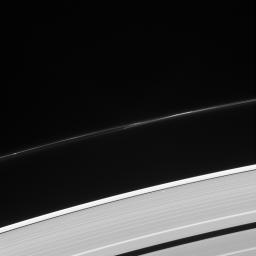Wish Upon a Star
Caption:
What's that bright point of light in the outer A ring? It's a star, bright enough to be visible through the ring! Quick, make a wish!
This star -- seen in the lower right quadrant of the image -- was not captured by coincidence, it was part of a stellar occultation. By monitoring the brightness of stars as they pass behind the rings, scientists using this powerful observation technique can inspect detailed structures within the rings and how they vary with location.
This view looks toward the sunlit side of the rings from about 44 degrees above the ringplane. The image was taken in visible light with the Cassini spacecraft narrow-angle camera on Oct. 8, 2013.
The view was acquired at a distance of approximately 1.1 million miles (1.8 million kilometers) from the rings and at a Sun-Rings-Spacecraft, or phase, angle of 96 degrees. Image scale is 6.8 miles (11 kilometers) per pixel.
Background Info:
The Cassini-Huygens mission is a cooperative project of NASA, the European Space Agency and the Italian Space Agency. NASA's Jet Propulsion Laboratory, a division of the California Institute of Technology in Pasadena, manages the mission for NASA's Science Mission Directorate, Washington. The Cassini orbiter and its two onboard cameras were designed, developed and assembled at JPL. The imaging operations center is based at the Space Science Institute in Boulder, Colo.
For more information about the Cassini-Huygens mission visit
http://saturn.jpl.nasa.gov
and
http://www.nasa.gov/cassini
. The Cassini imaging team homepage is at
http://ciclops.org
.
Cataloging Keywords:
| Name |
Value |
Additional Values |
| Target |
Saturn Rings |
|
| System |
Saturn |
|
| Target Type |
Ring |
|
| Mission |
Cassini-Huygens |
|
| Instrument Host |
Cassini Orbiter |
|
| Host Type |
Orbiter |
|
| Instrument |
Imaging Science Subsystem (ISS) |
|
| Detector |
Narrow Angle Camera |
|
| Extra Keywords |
Grayscale, Occultation, Visual |
| Acquisition Date |
|
| Release Date |
2015-01-05 |
| Date in Caption |
2013-10-08 |
|
| Image Credit |
NASA/JPL-Caltech/Space Science Institute |
| Source |
photojournal.jpl.nasa.gov/catalog/PIA18297 |
| Identifier |
PIA18297 |

 Planetary Data System
Planetary Data System
